Just like the any household appliances, your dehumidifier can also break down. When this happens, you have the option to repair the unit, replace the faulty components or purchase a new one.
We have put together list of electrical and mechanical fault and their repair methods to help you diagnose a dehumidifier; however, it is wise to make a decision based on costs of repair vs a brand new unit.
Depending on the diagnosis as listed below, I have put together approximate costs and recommendation to help you make an educated decision whether if it is worth repairing or just simply buying a brand new unit.
Refrigerant Leakage
Compressor-based dehumidifiers rely on refrigerants to convert moisture to water. The refrigerant is housed inside the coils, mostly made of copper. However, due to corrosion, factory defects, or normal wear and tear, the refrigerant in your unit could start leaking.
Refrigerant leakage causes your machine to take longer to start extract moisture or fail to work at all. To solve this issue, you may have the coils repaired or replaced.
Remember that conducting DIY repairs is not an option; the government encourages professional handling of Freon because it’s harmful to your health and the environment. As such, you will need to get services of a professional technician who will charge you around $50 to $70 per hour.
You may also incur additional charges for soldering or welding the perforations, which may cost you approximately $45 to $100, depending on the extent of the damage.
If you opt to replace the coils, you’re likely to part with $45 or more for the purchase. Another inevitable cost is the fee for recharging your unit with the new refrigerant, which will cost you somewhere between $3 to 20$ per pound, depending on your preferred refrigerant type.

Compressor Contains Refrigerant

Repair By: Professional Certified Technician
Material Costs: $ 50 – 100
Total Repair Costs: $ 100 – 200
Our Recommendation: Invest in a new dehumidifier
Failed Capacitor
Capacitor is used for preventing direct current (DC) from reaching the dehumidifier’s vital components; it only allows alternate current (AC) to pass through.
If the unit’s capacitor fails to work, the compressor won’t turn on, which means that the refrigerant won’t be pushed through the coils. As a result, your unit will run but fail to draw moisture from your indoor air.
Failed capacitors cannot be repaired, and the only option is to get a replacement. Capacitor prices range between $10 and $20; you may find some that are cheaper than others depending on your unit’s model.
If you have some knowledge regarding electricity and electrical components, you may save yourself a few dollars on installation labor. This means that replacing a defective capacitor is cheaper than purchasing a new moisture extractor.

Repair By: DIY or Professional Certified Technician
Material Costs: $ 25 – 50
Total Repair Costs: $ 50 – 100 (Work Completed by a Professional)
Our Recommendation: DIY
Faulty Fan or Motor
The fan and motor are the two main components responsible for drawing air into the unit. When either fails, your unit’s ability to pull humid air from your indoor environment is compromised.
To test which of the two component is defective, unplug the unit from its power source, lift the back cover and perform the following tasks:.
- Inspect the fan housing to ensure that the fan isn’t rubbing against the frame.
- You may also try to wiggle the fan to see whether it’s loose. If your suspicions are confirmed, ensure to tighten the screws.
- Rotate the fan gently by hand to determine whether it can move freely. If the fan stops when you let go or feels hard to move, you should have it replaced.
- If there are no issues with the fan, use a multimeter to determine whether the motor is receiving power. If there are no power conduction issues, but the fan still won’t run, contact an electrician or a dehumidifier expert to replace the motor.
The price for blower fans ranges between $10 and $30, depending on the quality and your unit type. Motor prices range between $10 and $50 depending on the make; basically, the more expensive the unit, the pricier its components.
The replacement cost for either item is typically less than $100. Purchasing these components plus the installation will cost you less than 200 dollars, meaning that repairing the unit is cheaper than getting a new one.



Repair By: DIY or Professional Certified Technician
Material Costs: $ 30 – 50
Total Repair Costs: $ 50 – 100 (Work Completed by a Professional)
Our Recommendation: DIY
The Overload Protector
An overload protector has the same working mechanism as a circuit breaker. But instead of monitoring the electric current going into your dehumidifier, it monitors the compressor’s heat. Generally, when the compressor becomes too hot, the overload protector cuts off the electric supply and restores it when the heat subsides.
Overload protectors mostly fail due to short-circuiting within the device itself or when there’s an electrical overcurrent in the main power supply. You may test the overload protector with a multimeter to see if it’s still effective. If not, it’s best to replace it with a new one, which will cost you an average of $5-$55.
This price range depends on the size and model of your unit. Large and high-end units will cost you more than their standard and smaller counterparts. If you’re confident with your electrical skill, you can save a few dollars by omitting installation charges. This implies that you shouldn’t replace your entire unit due to a defective overload protector.
Repair By: DIY or Professional Certified Technician
Material Costs: $ 5 – 55
Total Repair Costs: $ 50 – 100 (Work Completed by a Professional)
Our Recommendation: DIY
Condensate Overflow
Dehumidifiers with reservoirs rely on a float switch to halt the unit’s operations and prevent condensate overflow when the tank reaches capacity. If the switch is faulty, your unit will continue extracting moisture even when the tank fills up.
If you find that the bucket is full and the unit continues operating, it’s advisable to test the float switch to see if it’s obstructed. You may shake the bucket or tap it with your finger to determine whether the float switch can move freely; if not, inspect it for obstructions.
If the float switch is okay, inspect its assembly and its connection to the compressor, circuit board, or fan to see if there’s anything amiss. Have the float switch along with its assembly replaced if you detect any damage. To purchase a new float switch, you will part with $10 or less, making the repair more sensible than purchasing a new moisture extractor.
Repair By: DIY or Professional Certified Technician
Material Costs: $ 10 – 20
Total Repair Costs: $ 30 – 50 (Work Completed by a Professional)
Our Recommendation: DIY
The Bottom Line
Dehumidifiers are designed to last for two or more years, but like any other household appliance, you may experience either electrical or mechanical issues that may call for repair. Sometimes, you’ll find yourself in a quagmire wondering what is more sensible between conducting repairs and getting a new device. Well, there’s no simple answer as the right choice depends on the damage extent to your unit.
Ideally, minor issues like those involving the float switch or capacitor are easy to fix professionally or DIY. The components are also affordable, making repairs preferable to replacing an entire unit.
On the other hand, issues relating to coils and refrigerants are very complicated; it’s advisable to replace the entire unit rather than taking risks and spending more than $200 on repairs. Also, remember that the costlier the unit, the higher the price of its components.
Pro Tip: Ensure to purchase replacement components from your unit’s specific manufacturer and involve a technician if you lack the requisite skills to pull off DIY repairs. Before I let you go, I highly suggest you follow our recommendations on maintenance & cleanliness of your dehumidifier.
Disclaimer Note: Costs may vary by region; costs listed above are based on our experiences and working relationship with HVAC technician.
Updates: May 24 2021, Post was reviewed and edited by certified heating and cooling technician.
